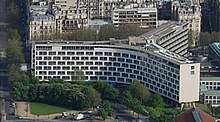World Heritage Centre
Coordinates: 48°50′58″N 2°18′22″E / 48.84944°N 2.30611°E

UNESCO Headquarters or Maison de l'UNESCO is a building inaugurated on 3 November 1958 at number 7 Place de Fontenoy in Paris, France to serve as the headquarters for the United Nations Educational, Scientific and Cultural Organization, (UNESCO). It is a building that can be visited freely.[1]
Design
The design of the UNESCO Headquarters building was the combined work of three architects: Bernard Zehrfuss (France), Marcel Breuer (Hungary), and Pier Luigi Nervi (Italy). Plans were also validated by an international committee of five architects composed of Lucio Costa (Brazil), Walter Gropius (United States), Le Corbusier (France), Sven Markelius (Sweden) and Ernesto Nathan Rogers (Italy), with the collaboration of Eero Saarinen (Finland).
Description
The main building, which houses the secretariat, consists of seven floors forming a three-pointed star. To this is added a building called the "accordion" and a cubic building, which is intended for permanent delegations and non-governmental organizations.
These buildings occupy a trapezoidal area of land measuring 30,350 square metres (326,700 sq ft), cut in the northeast corner of the semi-circular shape of the Place de Fontenoy. It is bordered by avenues of Saxony, Segur de Suffren and Lowendal.
Relations with France
The land on which the building is built is the property of the French State. By a decree of 22 December 1952, it was assigned to the Foreign Ministry to put at the disposal of UNESCO.[2] This was done by a lease for a term of 99 years, renewable at a nominal rent (1000 francs per year), near the end of the lease. In addition, the residence of this intergovernmental organization on the French territory is governed by a headquarters agreement that defines its privileges and immunities. Both agreements were signed in Paris in 1954, respectively on 25 June and 25 July.[3][4]
The French Parliament approved the lease by a law enacted on 6 August 1955,[5] authorized the President of the Republic to ratify the Headquarters Agreement. The Headquarters Agreement entered into force on 23 November 1955. It was published by a decree of 11 January 1956.[6]

World Heritage Centre in Japan
In December 2017, the 'Mt. Fuji World Heritage Centre, Shizuoka' was opened in Fujinomiya city. The appointed director was Atsuko Toyama, a 79-year old former bureaucrat of the Ministry of Education. Despite a striking building designed by world-famous architect Shigeru Ban, the Shizuoka World Heritage Centre quickly became a focus of controversy due to two out of five researchers quitting several months after the official opening, citing concerns of academic freedom and harassment. Notwithstanding continuing controversy, Shizuoka Prefecture and its governor Heita Kawakatsu have denied any wrong doing.[7]
See also
References
- ↑ Charlotte L Joy (15 January 2012). The Politics of Heritage Management in Mali: From UNESCO to Djenné. Left Coast Press. pp. 79–. ISBN 978-1-61132-094-7. Retrieved 22 August 2012.
- ↑ Decree of 22 December 1952 on the allocation to the Ministry of Foreign Affairs of building lands located at the Place de Fontenoy, Paris, Official Journal of the French Republic (JORF), No. 306, p. 11, 24 December 1952, p. 11, 894 on Légifrance.
- ↑ Salmon, Jean., Quelques remarques sur l'installation du siège de l'UNESCO à Paris, Annuaire français de droit international, Volume 4, pages 453–465, 1958.
- ↑ Fischer, Georges., Organisation des Nations unies pour l'éducation, la science et la culture : Accord relatif au siège, Annuaire français de droit international, Volume 1, pages 393-406, 1955.
- ↑ Loi n°55-1071 du 6 août 1955 : 1 tendant à autoriser le président de la République à ratifier l'accord entre le Gouvernement de la République française et l'Organisation des Nations Unies pour l'éducation, la science et la culture relatif au siège de l'Organisation des Nations Unies pour l'éducation, la science et la culture et ses privilèges et immunités sur le territoire français, signé à Paris, le 2 juillet 1954 ; 2 portant approbation du contrat de bail signé le 25 juin 1954 entre le Gouvernement de la République française et l'Organisation des Nations unies pour l'éducation, la science et la culture, relatif au terrain de la place de Fontenoy, à Paris (7e), affecté au ministère des affaires étrangères par décret du 22 décembre 1952, JORF n°190 du 12 août 1955, p. 8106, on Légifrance.
- ↑ Décret n°56-42 du 11 janvier 1956 portant publication de l'accord entre la République française et l'Organisation des Nations Unies pour l'éducation, la science et la culture, relatif au siège de l'Organisation des Nations Unies pour l'éducation, la science et la culture et à ses privilèges et immunités sur le territoire français, signé à Paris le 2 juillet 1954, JORF n°13 du 17 janvier 1956, p.625–628.
- ↑ [富士山世界遺産センター、2教授退職しピンチ]『Yomiuri Newspaper』Morning edition, April 3, 2018
Bibliography
- Le Siège de l'Unesco à Paris, preface by Luther Evans, introduction by Françoise Choay, photographs by Lucien Hervé, Gerd Hatje, Stuttgart, 1958.
External links
- Bienvenue au Siège de l'UNESCO - UNESCO